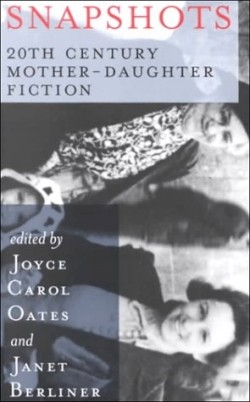Snapshots
20th Century Mother-Daughter Fiction
No woman wants to hear that she is her mother’s daughter, yet she is. Oates and Berliner have collected an album of seventeen candid snapshots of mother-daughter life. These stories, by prominent, international women writers, explore the umbilical connection that threatens to wrap around a daughter’s neck long after birth—the same cord she loops and throws high to lasso her mother’s love.
The collection is grounded in classics. Lorrie Moore’s “How to Talk to Your Mother (notes)” traces a daughter’s thoughts of what she can and cannot tell her mother in reverse order from just after her mother’s death back to her own birth. The renowned “A Rose in the Heart of New York,” by Edna O’Brien, chronicles a daughter’s life from the moment her mother, crucifix clenched between her teeth, pushes the girl out to the mother’s eventual death without reconciliation. One wonders if the editors, who hint at conversations they had over selection, saw this juxtaposition. More likely, the connection speaks to the universal nature of mother-daughterhood. O’Brien writes, “Her mother’s knuckles were her knuckles, her mother’s veins were her veins, her mother’s lap was a second heaven, her mother’s forehead a copybook onto which she traced A B C D, her mother’s body was a recess that she would wander inside forever and ever, a sepulcher growing deeper and deeper.”
Berliner admits that she mistook Margaret Atwood’s “Significant Moments in the Life of my Mother” for autobiography, a cause for some ribbing and a tribute to Atwood’s craft. Oates’ own “Death Mother” captures the psychotic need-tolerance continuum that exists between mother and daughter, even when that nurturer has grossly abused her own flesh-and-blood. (Death Mother should never have been fit for childbearing. She reappears in her daughter’s life like a gauzy apparition from which the girl must tangibly break free.)
The collection encompasses magical religiosity (Lois Gold), Latin sensual sensibility (Isabel Allende and Julia Alvarez) the pathos of political and cultural message (Gloria Naylor and Alice Walker), and what Oates deems philosophy of womanhood, told through sci-fi anthropology (Ursula LeGuin). The stories could have benefited from dating, offering the reader a contextual reference.
Yet, the new stories written for the anthology offer palpable insight into the relationship. Martha Soukoup’s “Up in Diamond City,” recreates the fantasy world a girl embodies to escape, if only momentarily, her mother’s psychoses. Mary Gordon’s “Cleaning Up” resonates with the metaphor of menstruation gone awry, present in many of the other stories. Berliner’s story, which so aptly concludes the anthology, reveals a writer’s indebtedness to the motherhood of her past, for good or ill, - and the writer’s capacity to renew for her daughter’s generation.
Reviewed by
Jo-Ann Graziano
Disclosure: This article is not an endorsement, but a review. The publisher of this book provided free copies of the book to have their book reviewed by a professional reviewer. No fee was paid by the publisher for this review. Foreword Reviews only recommends books that we love. Foreword Magazine, Inc. is disclosing this in accordance with the Federal Trade Commission’s 16 CFR, Part 255.

